What Is Local SEO and How to Do It Right
What does your local ma-and-pa store have in common with a high-end e-commerce website? Both can use search engines to drum up business. For the online store, the good-old search engine optimization is there to make sure it appears as close as possible to the top of the first page of search results. And the ma-and-pa store can use local SEO to increase sales.
For many, however, this thing called local SEO is still a bit of a mystery. Search engines have been working on localized query results for over fifteen years, but the local SEO field has only recently started to blow up. Now, it’s slowly becoming the norm for any type of business that offers services in a certain geographical area.
In this article, we’ll show you:
What Is Local SEO?

In the simplest terms, local search engine optimization is the process of optimizing your business’ online assets so that it ranks well in search results that answer a query with a local component. When someone is looking for a hairdresser in the area where you have a salon, you want your business name to be the first thing they see. Local SEO should help with that.
The thing that makes this kind of searching so important is the fact that it’s highly effective at bringing people through the door of brick-and-mortar businesses. One of the reasons is because people who search for things locally tend to present qualified traffic.
A lot of searches for local things happen from mobile devices, and they don’t always include a geographic term as much as the term “near me.” So, you have people who are probably on the go, looking for nearby shops that sell things that they want. It would be hard to find a stronger indicator of purchase intent than that.
The numbers might vary, but most would say that at least seven out of ten local searches end with an in-store visit. That’s the power of local search and the reason why, ever since Google’s 2014 Pigeon update, which focused on improving local search results, businesses have increasingly been relying on local optimization.

Local search results work a bit differently than regular search results. The way they are presented might vary slightly between different search engines, but there are certain similarities you can notice.
For example, the results are grouped in a pack that appears at the top of the results page. Google’s users will see three results underneath a map showing the business’ location. Bing’s users will see the same, but with five results.
Here’s how it looks on the respective search engines for the search terms “hairdresser near me” and “hairdresser nearby.”

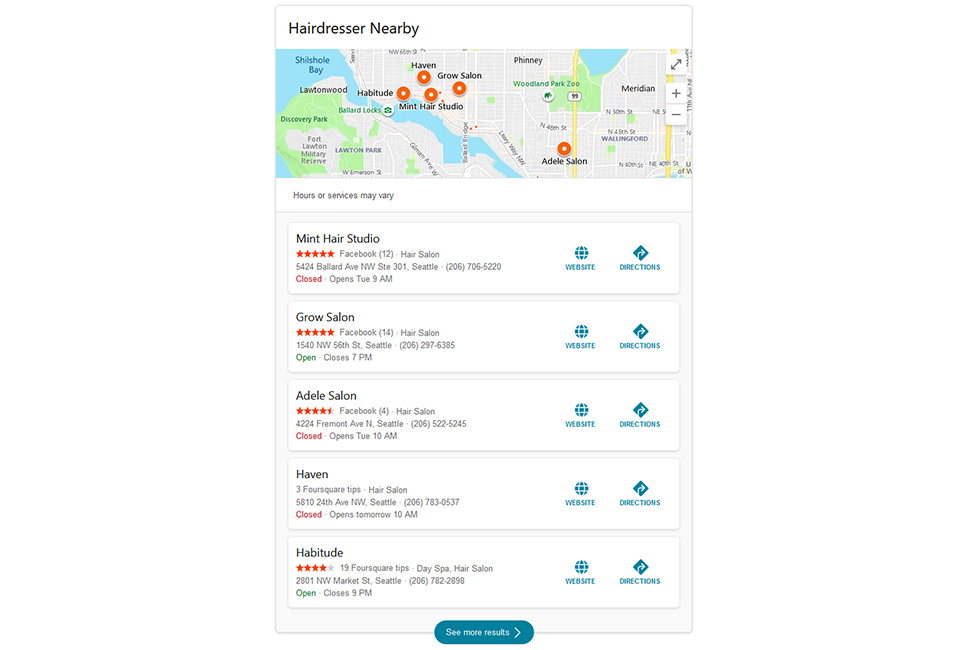
These aren’t the only results the user can get. Businesses should work towards appearing in this “snack pack” of search results because it increases their visibility, but they can still appear in the results when the viewer presses “view all” or “see more results.”
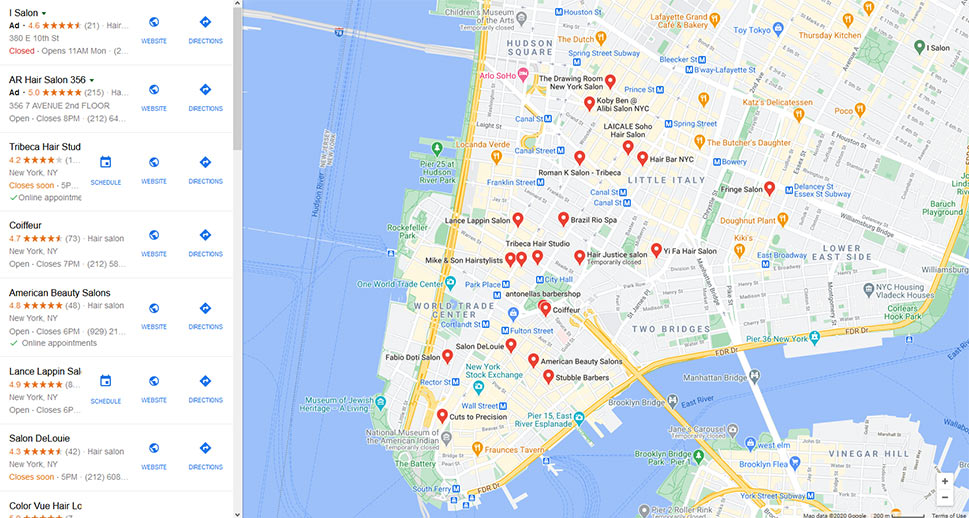
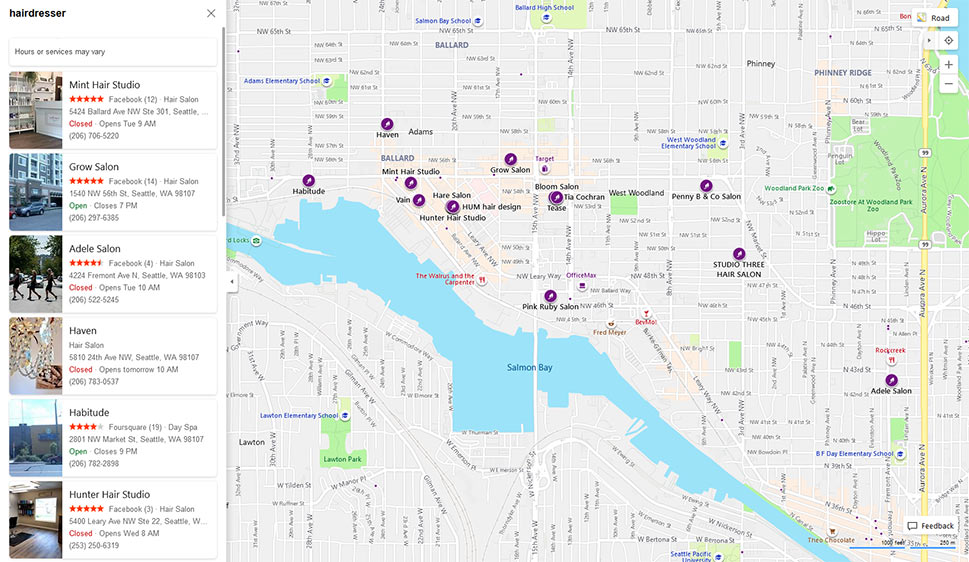
This time, the map becomes bigger, and there are more results visible. Click on one of the results will show a plethora of information about the business in question. This information includes name, ratings, address, working hours, contact information, website address, images, and user reviews.
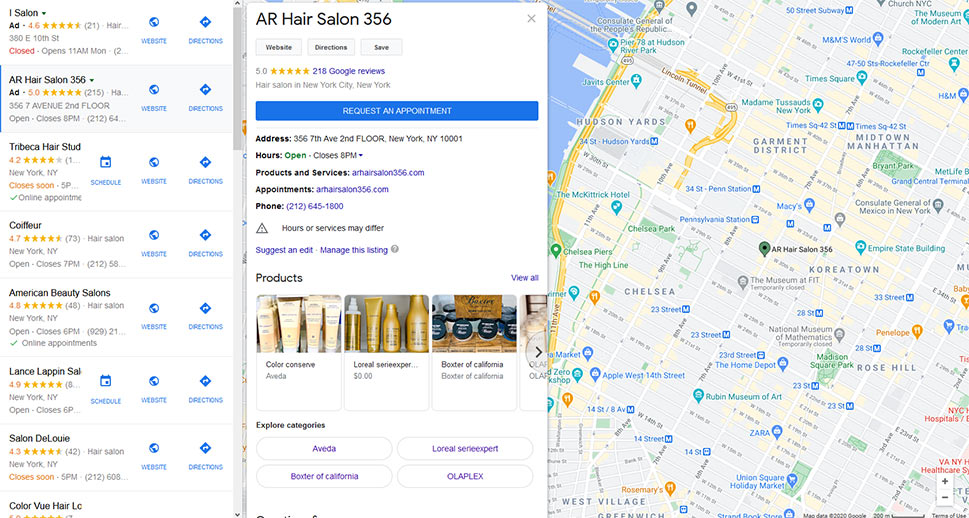
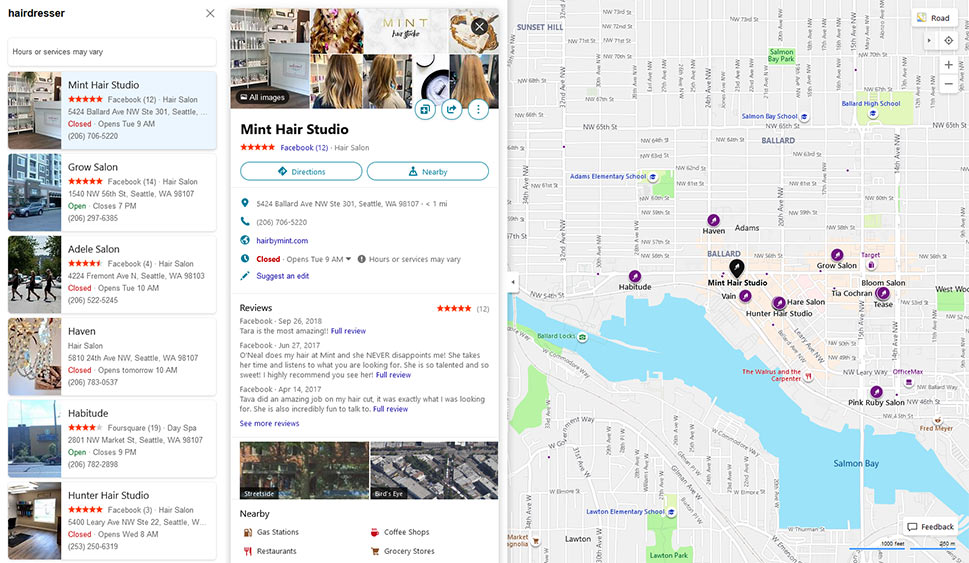
From your end, local search results work in a way that has you register your business with the search engine’s business directory of the equivalent and then provide as much information about it as possible.
That’s the short version, at least, because providing all that information includes getting users to review your business, have it listed on business directories, and do lots of other optimization stuff. For starters, however, let’s see how you can claim your business in the search engine’s business service.
This type of search engine optimization works without a website because it relies on the search engines’ business listing type of service. You can think about it almost like a social network for businesses where everything revolves around creating a good profile.
For Google, this service is called Google My Business. For Bing, it’s called Bing Places for Business. Either way, your local SEO journey starts with claiming your business there. Here’s how you can do it on Google.
Go to google.com/business, and click on the Manage Now button.
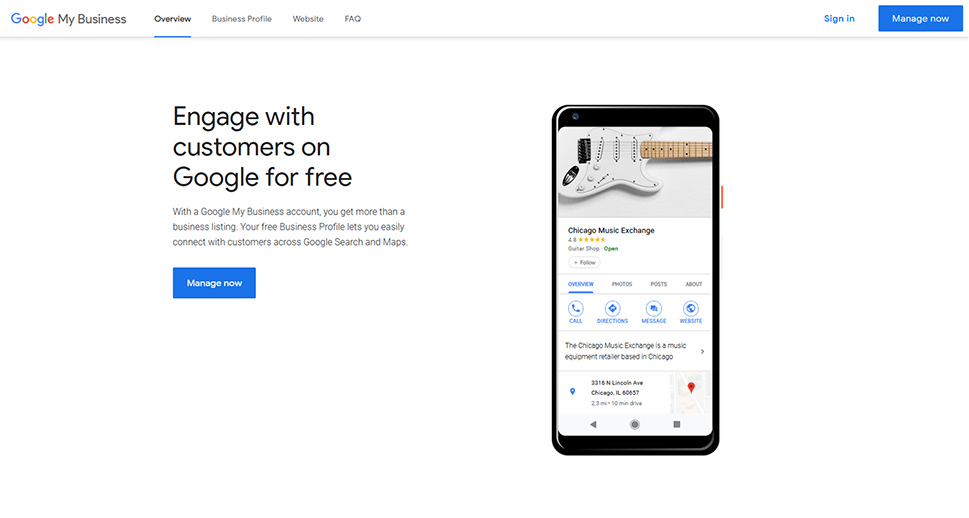
You’ll be asked to find and manage your business. If this is the first time you’re making the profile, you can go ahead and click on the blue hyperlink that says “Add your business to Google.”
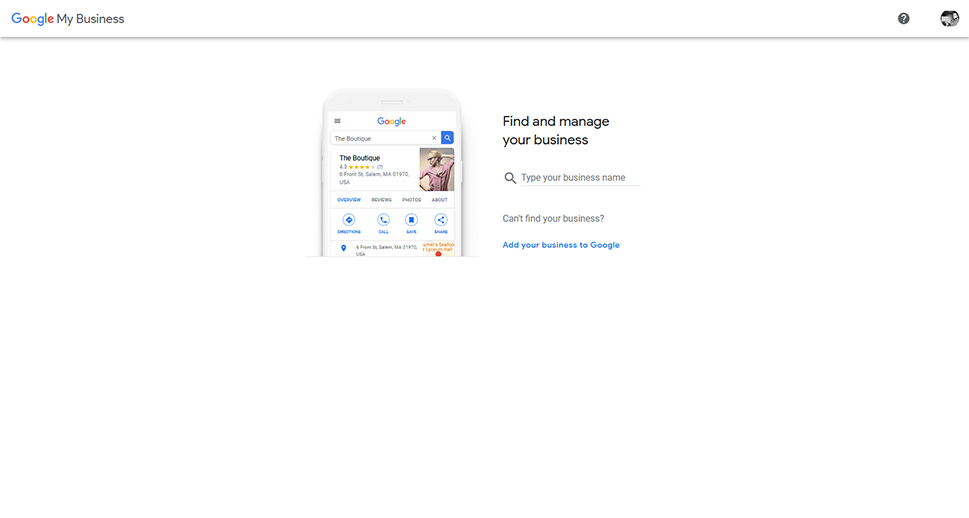
The next couple of steps will guide you through providing the necessary information for creating a listing. First, you’ll be asked to provide the name of your business. Next, you’ll be able to choose the category your business belongs to, whether you want to add a physical location or not, the address, the location on the map, optional phone number, and website, and that’s it! You might be asked to verify your business. That should be enough to get your website online – but you shouldn’t do it just yet.
Before you decide to go online, you should go to Google My Business and check out the Info option in the dashboard. It will list all the information available about your business.
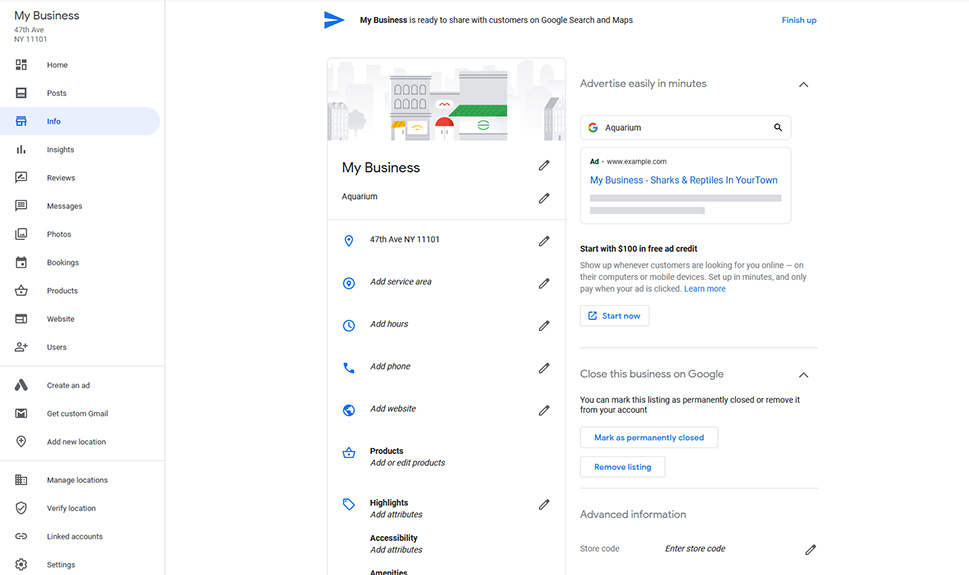
Among the information you can add, you’ll find highlights, accessibility options, amenities, business descriptions, and photos. Some of the options you can find here are the same ones you can choose from the dashboard. For example, you can choose Photos from the dashboard and there you’ll be able to add photos including a cover photo, logo, photos of the interior and exterior of your business, and even your team members.
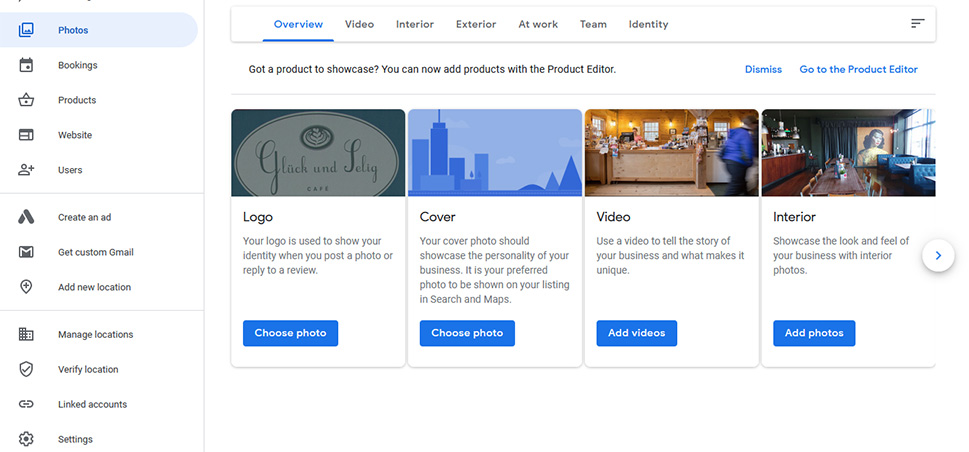
The bottom line is that you should check out all of these options and fill them out with as much information as you can. Every bit of information you can add here matters a lot. Once you’ve finished, you’ll be able to get your listing online. That’s great news, but that won’t be nearly enough.

Your next step should be, of course, to go through the same process on Bing Places for Business. It doesn’t matter if you think that no one uses Bing – the whole idea is to have your business information appear in as many online directories as possible, and you can consider Bing Places for Business as one.
From there, you can head over to real online directories such as Foursquare and Apple Maps, and claim your business in those places, too. Next, you’ll want to head to Yelp and other review websites and claim your business there as well. Every place where your business name appears with your business’ information is a citation, and the more of these you have, the better. Plus, it will make it easier for people to find you.
Does your business use social media? No? Well, what are you waiting for? It’s possible to create a Facebook Business Page, just as it’s possible to create a listing on other networks such as Twitter or LinkedIn. Make the most out of these. If you don’t plan to use them, at least provide the relevant information and keep it up to date.

You want your website to have reviews. Google will use its reviews, but any review your business can have online will count. You should run a campaign for people who’ve used your business to leave reviews.
A campaign doesn’t have to be as complex as it sounds – you can simply print out a QR code linking to your website’s listing on a review website, put it somewhere near the cash register, and just ask people to leave a review if they have the time.
You might want to skip asking people who don’t look like they would give a decent review – this might be cheating a bit, but it’s really important to have as many good reviews as possible. Of course, consistently providing a good user experience might be the best way to ensure that the reviews you get are good. If you do get a bad review, you should reply to it. It’s review management 101, so make sure you follow all of the best practices.
Just so you know, your ideal review should be well-written and positive. It should also contain keywords and references to your business’ location.

When you’re optimizing your website for local search – or building it from scratch to rank it for local search results – you don’t do things too differently from when you’re optimizing or building a regular website. You’ll still create a homepage, add metadata, and research keywords – you’ll just do it so that they include local terms or queries people in your area might have. Let’s see some examples where you should focus your attention.
The Homepage
When a visitor comes to your homepage, it shouldn’t take them more than a couple of seconds to figure out who you are, what you have to offer, and where you’re located. Google’s crawler isn’t exactly the regular website visitor, but you should still provide them the same information.
Your homepage has tags and meta descriptions that should be edited to include terms that can identify your business’ location. That can be, for example, the name of the city. In a big city, it can also be the name of the part of the city where the business is located. If it helps Google understand which area the business is located in, it could go in the homepage’s tags and descriptions.
Metadata
If you’re updating the title tags and metadata on your homepage, there’s no reason why you wouldn’t do it on every other page you have on your website. The data might differ from one page to another, but the general rule is the same for all of it.
Good SEO practices state that you should have keywords in the metadata. For local optimization, you should ensure that you also include terms that denote your business’ location – the name of the city, county, neighborhood, whatever you want to focus on.
Keywords
You will, of course, have to research relevant keywords for your website – whether you plan to optimize it for local search or not. However, if you’re researching locally-relevant keywords, you’ll have to research with a twist.
While you’re using Google AdWords, Ahrefs, Google autocomplete, and even Craigslist to find out what words people are using to search for stuff, make sure that you always focus on searches that happen on a local level. So, either narrow down the search to a specific geographic area, if your resource allows it, or include a toponym of your choice in the keywords you’re looking for.
Content
The content you create for your website should always include the keywords that are relevant to the area where your business is located or where you offer a service or sell a product. You can achieve this, for example, by including plenty of local geographical terms in the content.
However, if you want to create good local content, and catch the eye of someone who’d want to maybe link to it, you might want to adopt another strategy. Instead of creating content you optimize for local search by using local keywords, you should create locally relevant content. Find topics that matter to the people who live in the area and cover them in your content.
Website Structure
As a business owner, you don’t have to limit yourself to a single area. Sure, proximity is one of the key factors for appearing in the snack pack of search results, but that has nothing to do with how you do your business. If you’re a plumber in a big city, you don’t have to focus on providing a service in a two-mile radius around your location. You’ll venture to other parts of the town, too.
The trick is to have a separate page for every part of the city where you can go – whether it’s a borough, a neighborhood, or however the city is divided. Then optimize the page specifically with keywords and metadata for that specific sub-location.
Add the LocalBusiness Schema
Using LocalBusiness schema, you can make sure that a search engine has the right understanding of all the elements on your page and that it knows how to display them so that people can read them. This is what you get by using schema markup on your website, and it can be incredibly helpful to users.
The LocalBusiness schema contains the properties that are relevant to local businesses. Google will require you to add only a handful such as an URL, physical address, and name of the business. You can also include anything from geographic coordinates to menus, working hours, contact information, and reviews. If you’re not sure how to get started with it, Google has made a tool to help with that, as well as a tool to test your page after you’ve added the code you’ve created with the markup helper.
Let’s Wrap It Up!
When you’re optimizing a website for local SEO, you should understand that some circumstances will be out of your hands. The proximity of the searcher, for example, is a strong ranking factor and you have no control over it whatsoever.
But the things you can do, you should do diligently. Fill out as many listings for your website as possible. Always be on the lookout for comments, and ready to reply. And make sure that you produce content the locals would find interesting.
